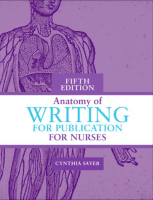Beth, a former hospital nursing director-turned-faculty member, learns she has to present her research at a national conference and write it up for publication and funding. Like many nursing faculty members and researchers, she enjoys conducting research because the evidence it yields allows her to help more patients.
She wants to get the word out about her exciting research results, but she lacks experience and confidence in writing research articles. “Oh, no!” she thinks as she reads the conference guidelines for submitting a 300- word abstract. “I’m used to charting and writing staff memos, but this abstract calls for formal, peer-reviewed, competitive writing. That’s a whole new ball game.”
Anxiety sets in. For Beth and others like her, the stakes are high. Unless she successfully presents her research, writes grants, and publishes, she can’t advance her career. Luckily, she has heard from a research writing coach about the OJISH model—a smarter, faster way to use the abstract writing process to jumpstart current and future research papers.
Abstracts as strategic screening devices
Today’s abstracts are much more than simple summaries. They’re highly strategic mini-stories that create a first impression of a researcher’s work and position it effectively to those who matter.
When writing abstracts, many researchers make one of two common mistakes: They underestimate the difficulty of the task and dash off a perfunctory summary that falls flat, failing to capture the novelty or significance of the research. Or they overestimate the difficulty of the task and spend a great deal of time trying to distill a lengthy, complex project into a 300-word abstract, only to tear it up because “it isn’t any good.” At that point, perfectionism is paralyzing, as writing coach Paul J. Silvia states in his book, How to Write a Lot: A Practical Guide to Productive Academic Writing.
Either mistake can cost a researcher acceptance. Research shows decision makers use abstracts as filters to greenlight some submissions and stop others in their tracks. In fact, at some high-profile medical journals, a submission may be rejected (not even sent out for peer review) based on the editor’s impression of the abstract alone, according to John M. Swales and Christine B. Feak, authors of Abstracts and the Writing of Abstracts. The authors add that the abstract serves as stand-alone text, a road map for readers and reviewers, and an indexing tool for librarians, editors, and research consumers.
Why abstracts are hard to write
Few sections of a presentation, paper, or grant are more critical to a submission’s overall success than the abstract. An abstract is short, typically less than a page of text. So how hard can writing 300 words be?
Anyone who has ever tried to write a citable title, a profound 140-character tweet, or one of today’s popular six-word Internet essays knows how hard it is to write something short—well. Abstracts, which can range from 50 to 600 words depending on the final purpose, pose a particular challenge for research writers, thanks to the size and scope of most projects. Typically, researchers must capture months or years of scientific thinking, complex processes, and detailed work in an arbitrarily finite amount of time and space—sometimes before they’ve even completed the research.
This task is hard, even for expert research writers, assert Swales and Feak: “[Word] limits make the already difficult task of constructing abstracts even harder. Even experienced and widely published authors usually have to produce several versions before they are satisfied that they have summarized their longer texts with maximum efficiency, clarity, and economy.”
That’s why, in this and other types of academic writing, the key is to “write first, revise later,” as Silvia says. “Generating text and revising text are distinct parts of writing—don’t do both at once…The quest for the perfect first draft is misguided.” With an abstract, one of the best ways to jumpstart the “write first, revise later” process is to start with a proven storytelling structure that helps you organize volumes of information efficiently and effectively.
Write first, revise later with OJISH
Applied linguists and rhetoricians have been studying research writing for several decades and have identified organizational structures for achieving better and faster first drafts of research texts, including abstracts. One such structure is OJISH—a mnemonic developed by journalist and educator Jennifer L. Greer, PhD, while teaching research writing at the Graduate School of the University of Alabama at Birmingham (UAB). (Greer is coauthor of this article.)
The OJISH model is based on the work of Swales, Feak, and other researchers who’ve identified common rhetorical “moves” in research abstracts. “Moves” are formulaic phrases or sentences (for instance, “little is known about” or “few studies have addressed”) that are identified through discourse or text analysis as strategic language a writer uses to advance the story to the next phase.
OJISH prompts the research writer to work through five moves in quick succession, using a 10-minute timed writing exercise followed by a 10-minute pair-share feedback session. Each of the five moves is part of the OJISH mnemonic:
O: Outline a pressing problem in the field.
J: Justify a new study with a gap in the literature.
I: Introduce the purpose of the proposed or present study.
S: Summarize the methodology (briefly).
H: Highlight the major findings (interpreted, not raw, results).
Analyze the moves in a sample OJISH abstract
Appropriate for a variety of academic texts, including empirical and review articles, OJISH offers writers a narrative structure that organizes the disparate parts into a logical story of inquiry in a concise way. As you can see from analyzing the student’s sample text that follows, you can easily pick out the classic moves in the research mini-story (in this case, an integrated literature review) and see how neatly it flows. You can also see how important each move is to the overall story and what happens if a move is missing. For example, if the sample abstract started with the J move or I move, bypassing the O move, it would lack a strong problem statement or rationale for publishing and funding.
The sample student OJISH abstract (written by UAB student Vanessa Gaisso, PhD) shows how the five moves capture key elements of the narrative in a real research project.
[O: Outline a problem] For more than a decade, Latino adolescents in the United States have indicated a number of problems related to risky sexual activity, such as unprotected sex and multiple partners. Previous studies of non-Latino adolescents show that such unsafe activities are associated with parenting variables. These variables include parenting behaviors (such as monitoring, supervision, involvement, and discipline), parenting values related to sexuality, parent-adolescent communication, parent-adolescent relationship (such as warmth, closeness, conflict, and attachment), and family structure. A growing body of research has focused on the link between these variables and risky adolescent behavior in Latino families. [J: Justify a new study with a gap] Yet few systematic reviews of this literature have been conducted.
[I: Introduce purpose] The purpose of this study is to present [S: Summarize methods] an integrative review of 31 studies (from 1998 to 2010) that examined the relationship between parenting variables and Latino adolescents (ages 11-19) living in the United States. [H: Highlight findings] Findings suggest positive relationships between parenting variables and unsafe sexual practices among adolescents. For example, significant differences exist in relationships between adolescent sexual activity and parent-adolescent communication, based on the gender of the adolescent or parent and on whether the parent or adolescent provided the data. Studies support the importance of interventions that help parents communicate their values and expectations related to adolescent sexual activity. In addition, they offer direction for the development of culturally appropriate interventions to reduce problems associated with risky adolescent sexual behaviors (such as unplanned teen pregnancy and sexually transmitted diseases, including HIV and AIDS).
Success with OJISH
For several years now, UAB School of Nursing faculty have used OJISH in graduate writing courses and assignments to help students begin their transition from workplace to research writing. The OJISH hands-on group-writing activity enables students to draw on previous work experience (based on a problem in practice) and to “think on paper” about an empirical research project from start to finish. Even students who’ve never conducted research state that OJISH engenders confidence because it let them quickly see how they might craft and write a study. Both faculty and students have embraced the model, saying it simplifies the process, offers a better way to review abstracts, enhances effectiveness and efficiency in creating first drafts, and lets them concentrate and focus on the exact message.
As a researcher, you can open doors to presenting, funding, and publishing your research by:
• starting with a proven organizing structure like OJISH
• adopting a “quick write” pair-share and revising strategy
• embracing a prewriting process as a way to test the strength of the research project. (See “Quick write” tips with OJISH.)
So instead of approaching your next abstract with anxiety and procrastination, use this short but highly strategic process to begin to develop your own professional voice and research writing style.
Jennifer L. Greer is a journalist and retired assistant professor of education specializing in academic writing and presenting in Birmingham, Alabama. Nancy P. Wingo is assistant professor of nursing at the University of Alabama at Birmingham. For a copy of the OJISH writing tool used by the authors.
Selected references
Belcher WL. Writing Your Journal Article in Twelve Weeks: A Guide to Academic Publishing Success. Thousand Oaks, CA: Sage Publications, Inc; 2009.
Silvia, PJ. How to Write a Lot: A Practical Guide to Productive Academic Writing. Washington, DC: American Psychological Association; 2007.
Swales JM, Feak CB. Abstracts and the Writing of Abstracts. Ann Arbor, MI: University of Michigan Press; 2009.


















